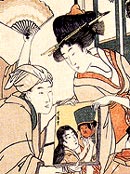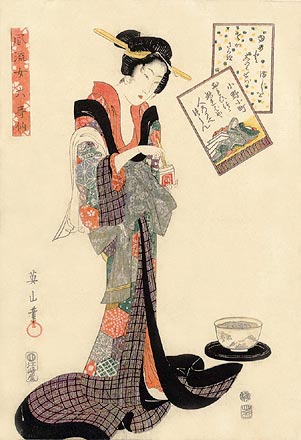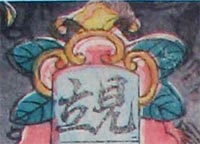

Mitate-e (見立絵)
The 'mitate' method used by ukiyo-e artists borrowed from these poetic techniques, resulting in pictorial designs that offered imaginative, simultaneous, and multiple layers of meaning that coexisted rather than blended. There was pleasure to be gained from the recognition of the complex linking of seemingly unrelated subjects. One of the chief characteristics about the products of Edo-period culture was the awareness on the part of its relatively knowledgeable audience that they were engaged in a "doubling" experience (shukô) in which a work of art was reflective of itself and its contemporary audience as well as referential toward earlier works or historical periods. Mitate-e are among the most enjoyable and challenging of Japanese print genres. In addition to likening one thing to another, mitate can also mean, literally, "seeing with one's own eyes." Mitate was a metaphorical, often playful or ironic connection made in popular Edo-period art and literature that linked the contemporary with the historical (either the recent or distant past). It also combined the vulgar with the refined (zoku and ga). Mitate takes many forms in ukiyo-e. Contemporary figures are substituted for historical ones, or contemporary events are meant to represent events from the past. Thus a contemporary courtesan might be compared to a great historical poet, or a commoner with a heroic medieval warrior. In the image above on the right, the artist Kikugawa Eizan portrayed a courtesan by identifying her as a modern analogue of the poetess Ono no Komachi. The series title Furyû onna rokkassen (Fashionable women and six immortal poets) and the poem card depicting and naming Komachi make the connection explicit.
Another use of the term mitate was to signify an actor in a performance that did not take place, or for a role he was never known to have portrayed. This was a fairly common occurrence in Osaka printmaking, although it is also found in Edo prints. (The image on the left — with the characters for mitate (見立) — is taken from the upper part of a title cartouche used in an Osaka actor tetraptych.) So patrons of the actors sometimes commissioned portraits of their favorite actors in roles they never performed, or rival actors paired up in roles they never shared on stage together. Celebrated deceased actors were also portrayed in performances that actually took place after their deaths. ©1999-2019 by John Fiorillo Return to FAQ |
Viewing Japanese Prints |
 Mitate-e ("look and compare pictures" or analogues" 見立絵) were among the most common and important genres in ukiyo-e printmaking. The earliest use of the term mitate may have been in 1638 in relation to haikai poetry technique. In critical discussions of waka poetry, mitate is generally used as a term denoting figurative language of many kinds, much of the time involving indirect metaphors or comparisons.
Mitate-e ("look and compare pictures" or analogues" 見立絵) were among the most common and important genres in ukiyo-e printmaking. The earliest use of the term mitate may have been in 1638 in relation to haikai poetry technique. In critical discussions of waka poetry, mitate is generally used as a term denoting figurative language of many kinds, much of the time involving indirect metaphors or comparisons.  Allusions to classical poetry were common in mitate, but whether these references were meant to produce literal equivalence depends on the specific example. Sometimes these connections were direct, at other times they were so oblique as to establish a barely recognizable allusion. In the latter case mitate was often used to suggest historical resonance or lend an aristocratic glow to otherwise contemporary customs, manners, or events.
Allusions to classical poetry were common in mitate, but whether these references were meant to produce literal equivalence depends on the specific example. Sometimes these connections were direct, at other times they were so oblique as to establish a barely recognizable allusion. In the latter case mitate was often used to suggest historical resonance or lend an aristocratic glow to otherwise contemporary customs, manners, or events.